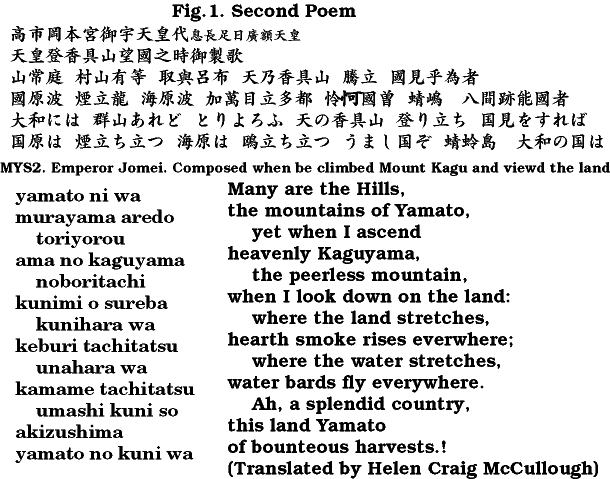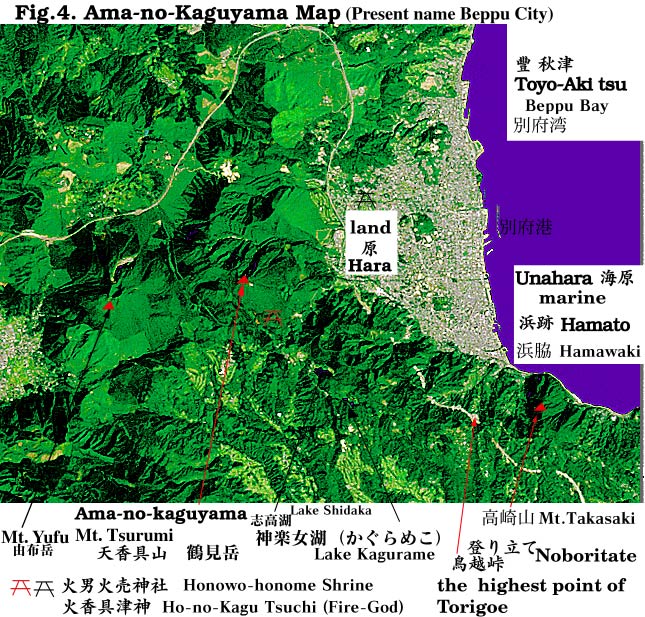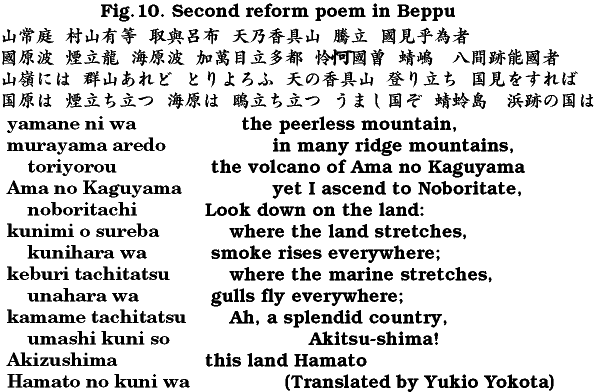Second
: None of the poem was composed in Yamato
This is the second poem in Man'yoshu . It is said to be composed by Great King Jomei
. It is said to be composed by Great King Jomei in Yamato
in Yamato . But that
is not necessarily one and only interpretation.
. But that
is not necessarily one and only interpretation.

MYS2. Emperor Jomei composed this poem when he climbed Mount Kagu and viewed the
land.
yamato ni wa
murayama aredo
toriyorou
ama no kaguyama
noboritachi
kunimi o sureba
kunihara wa
keburi tachitatsu
unahara wa
kamame tachitatsu
umashi kuni so
akizushima
yamato no kuni wa
Many are the Hills,
the mountains of Yamato,
yet when I ascend
heavenly Kaguyama,
the peerless mountain,
when I look down on the land:
where the land stretches,
hearth smoke rises everywhere;
where the water stretches,
water birds fly everywhere.
Ah a splendid country,
this land Yamato
of bounteous harvests
(Translated by Helen Craig McCullough)
1) There are no scenery in Yamato at Asuka in general.
First, the word "toriyorou,  " is, in Japanese, meant peerless mountain
which stands out from the others. But there is no such a particular feature in
Kaguyama hill in Yamato. It attracts least attention among the Three Hills of
Asuka(Yamato)
" is, in Japanese, meant peerless mountain
which stands out from the others. But there is no such a particular feature in
Kaguyama hill in Yamato. It attracts least attention among the Three Hills of
Asuka(Yamato)  . Evidently,
the top of lower hill of Kaguyama commands a poor view.
. Evidently,
the top of lower hill of Kaguyama commands a poor view.
Therefore, in no case should the sea watch from Kaguyama hill in Yamato
at Asuka. Similarly, seldom should gulls do seen at Asuka. Specifically, none
of the smoke does mean.
(Kaguyama-hill is 162 meters high, Ruins of Fujiwara Palace is 75 meters high,
and Mt.Nizyou is 517 meters high above the sea level.)
Thus the ordinary interpretation of this poem differs in the facts
of geography.
Second, it is difficult, if not impossible, to read for "Yamato"
both" "and "
"and " " with two Man'yo-kana
" with two Man'yo-kana words.
words.
First "Yamato" is written in " ." But
this case has no precedent. Normally "
." But
this case has no precedent. Normally " , toko"
can not pronounce "
, toko"
can not pronounce " , to" in the reading
methods of Man'yo-kana. Commonly it should take last syllable "ko" in
"
, to" in the reading
methods of Man'yo-kana. Commonly it should take last syllable "ko" in
" , toko" . But "yamako,
, toko" . But "yamako, " makes no sense. Another pronounce
of "
" makes no sense. Another pronounce
of " " is "tune."
If you take last syllable of "
" is "tune."
If you take last syllable of " , tune" by the methods of Man'yo-kana, the word would
be read as "yama-ne,
, tune" by the methods of Man'yo-kana, the word would
be read as "yama-ne, ,
, ." This reading is very natural, because there are, for
example, family name "yamane
." This reading is very natural, because there are, for
example, family name "yamane  ", and
local name "Shimane Provence
", and
local name "Shimane Provence  ". If
it can be read so, this phrase can be interpreted as to stand out from other mountains.
". If
it can be read so, this phrase can be interpreted as to stand out from other mountains.
Second Yamato is written in " ." But
there is no precedent of this "Yamato." In no case could this word understand
as Yamato. On the other hand, under the methods of Man'yo-kana, "
." But
there is no precedent of this "Yamato." In no case could this word understand
as Yamato. On the other hand, under the methods of Man'yo-kana, " " can be read as "ha." In this case,
the word "hamato,
" can be read as "ha." In this case,
the word "hamato, ,
, " means seaside.
" means seaside.
In conclusion, neither of two words can be read as "Yamato".
And there is no reason to believe that this poem was composed at Asuka in Yamato
by Great King Jomei .
.

2) It is necessary for us to put new point of view provided
that this poem was not composed in Yamato. This section seeks to pursue this problem.
First, it is the focus for "Akitsu-shima, " instead of Yamato. It appears
as "Oho-yamato Toyo no aki-dzu(tsu)-shima,
" instead of Yamato. It appears
as "Oho-yamato Toyo no aki-dzu(tsu)-shima, " in Kojiki (Records of Ancient Matters,
" in Kojiki (Records of Ancient Matters, ). In ancient ages, "Oho-yamato Toyo,
). In ancient ages, "Oho-yamato Toyo, " is a part of "Oita Prefecture
" is a part of "Oita Prefecture " in "Kyusyu
" in "Kyusyu ." "Aki-tsu,
." "Aki-tsu, " mean "Beppu Bay
" mean "Beppu Bay ". One of the traces is the existence of "Aki-machi
". One of the traces is the existence of "Aki-machi ", the town that
situated at the entrance of Beppu Bay. "Akitsu-shima,
", the town that
situated at the entrance of Beppu Bay. "Akitsu-shima, " means "Kyusyu,
" means "Kyusyu, " island
to be seen from the sea.
" island
to be seen from the sea.
Therefore, it is possible to think that this poem was composed in
"Beppu ."
."
Second, it is the next focus for "Ama no Kaguyama, ." Through
ancient times, according to "Wamyou-sho
." Through
ancient times, according to "Wamyou-sho  " etcetera, "Beppu Bay
" etcetera, "Beppu Bay " has been known
as a part of the place called "Ama
" has been known
as a part of the place called "Ama ."
The trace is the existence of the place name of "North and South Ama-be Gun
."
The trace is the existence of the place name of "North and South Ama-be Gun ."
."
The aim of the next investigation is to search out whether Mt.Tsurumi,
the outstanding mountain in Beppu, had been called "Kaguyama" or not.
One trace is the Fire God "Ho no Kagu Tsuchi (  )" in "Honowo-honome
Shrines" which exist at the plain and the mountain side. The other trace is
"Lake Kagu-ra-me
)" in "Honowo-honome
Shrines" which exist at the plain and the mountain side. The other trace is
"Lake Kagu-ra-me  ." The roots of both word is "Kagu,
." The roots of both word is "Kagu, " which seems to mean sacredness.
" which seems to mean sacredness.
Therefore, it is possible to think that Tsuchi-gumo people had refered
to Mt.Tsurumi as "Kagu-yama" before they were ruled by Ama people. "Kagu-yama"
must be a sacred volcano worshipped by "Tsuchigumo people " in
Jomon period.
" in
Jomon period.
In fact, Mt.Tsurumi had historical eruption in A.D.867 which was recorded
in "Sandai-zituroku  ." That violent eruption had cut off the peak
of Mt.Tsurumi that had been supposed to have almost 2000 meters high, and it's
melted stones flowed into the river, and exterminated fishes. It is said Mt.Tsurumi
had been higher than Mt.Yufu on the record of "Honowo-honome Shrine."
In addition, Mt.Tsurumi was a famous volcano that numerous violent eruptions had
recorded in "Remnants of Iyo-Fudoki
." That violent eruption had cut off the peak
of Mt.Tsurumi that had been supposed to have almost 2000 meters high, and it's
melted stones flowed into the river, and exterminated fishes. It is said Mt.Tsurumi
had been higher than Mt.Yufu on the record of "Honowo-honome Shrine."
In addition, Mt.Tsurumi was a famous volcano that numerous violent eruptions had
recorded in "Remnants of Iyo-Fudoki ."
."
( Mt. Tsurumi is 1375 meters high, Lake Kagurame is 600 meters high, and Mt.Yufu
is 1583 meters high above sea level.)
On the other hand, Kaguyama hill in Yamato is called "Ame no
Kaguyama, , Rain of Kaguyama," because
on the hill the rite for rain has performed so that it was revered by people.
There is no existence of the name place "Ama
, Rain of Kaguyama," because
on the hill the rite for rain has performed so that it was revered by people.
There is no existence of the name place "Ama  " in Yamato. Absolutely there is no volcano
at Aska.
" in Yamato. Absolutely there is no volcano
at Aska.
Such a comparison made it clear that this poem is difference to two
interpretation. Furthermore, it become clear that we can refer to Mt.Tsurumi as
"Ama no Kaguyama, ."
."
3) Compared to the conventional interpretation, this new
interpretation is claimed to be more productive. All scenarios are commanding
that this poem was composed in Beppu.
First, Mt.Tsurumi is the outstanding mountain. Before violent eruption,
it must had been peerless.
Second, in Beppu, steam smokes of Hot Springs constantly rise, especially
well in winter. Beppu in Oita Prefecture is very famous in Hot Springs. In addition,
we can always watch gulls in nearside of the sea in winter.
Third, each steps of this poem involve old place names in Beppu, such
as Ama , Noboritate
, Noboritate , Hara
, Hara and Akitsu
and Akitsu . Especially finding the old place name Noboritate
. Especially finding the old place name Noboritate I convince that this poem is composed in Beppu, not in Yamato.
In addition, the common place names, or family names are included in this poem,
such as Yamane
I convince that this poem is composed in Beppu, not in Yamato.
In addition, the common place names, or family names are included in this poem,
such as Yamane  , Murayama
, Murayama
 , Kunimi
, Kunimi  , Kunihara
, Kunihara
 , Unabara
, Unabara  , and Hamato
, and Hamato
 .
.
Finally, for these reasons, the author of this poem come to Beppu
from the sea, stay in hot spring, and go out for land-viewing to the highest point.

yamane ni wa
murayama aredo
toriyorou
Ama no Kaguyama
Noboritachi
kunimi o sureba
kunihara wa
keburi tachitatsu
unahara wa
kamame tachitatsu
umashi kuni so
Akizuhima
Hamato no kuni wa
The peerless mountain,
in many ridge of mountains,
the volcano of Ama no Kaguyama.
yet I ascend to Noboritate,
Look down on the land :
where the land stretches,
smoke rise everywhere ;
where the marine stretches,
gulls fly everywhere.
Ah, a splendid country,
Akitsu-shima
this land Hamato
"Noboritate,  " is one of a sample
of old place names, which means situated by the side of cliff and having a fine
view.
" is one of a sample
of old place names, which means situated by the side of cliff and having a fine
view.
4) Similarly to other poems, the interpretation of this
poem allows us to make clear the points as follows.
1. The trustworthy part of a poem is the poem itself. The poem is the primary
material.
2. "Tyusyaku, , note to the poem" is not
the primary material. That is a secondary material that suggest "the interpretation
of the anthologist when he compiled the book."
, note to the poem" is not
the primary material. That is a secondary material that suggest "the interpretation
of the anthologist when he compiled the book."
We have thought for years that this poem was composed in the period
of Great King Jomei  (A.D 593-641). If this
poem is thought to be a land-viewing song ("Kunimi uta,
(A.D 593-641). If this
poem is thought to be a land-viewing song ("Kunimi uta, 
 ") , it must be
composed by Ama tarishihoko
") , it must be
composed by Ama tarishihoko depicted
in Sui shu
depicted
in Sui shu .
.
With these interpretations, we gain much wider recognition about this
poem.
(Translated by Yukio Yokota. Revised by Hajime Ohwada.)
Works Cited
Brocade by Night
"Kokin Wakasyu" and the Court Style in
Japanese Classical Poetry
Helen Craig McCullough
Stanford University Press
Stanford,California
1985
TWO
Pre-Heian Song and Poetry
EARLY SONG
P76-77
Man'yoshu
Ian Hideo Levy,
A translation of Japan's premier anthology of classical poetry
Volume one
University of Tokyo Press
Princeton University Press
Vol.1, Book1, pp.38
I look forward to hearing from you, please send E-mail to here.
to Source Document This Document mixed
with Japanese.
Back to Home Page
Created by "Yukio Yokota"
Copyrighted by "Takehiko Furuta"


